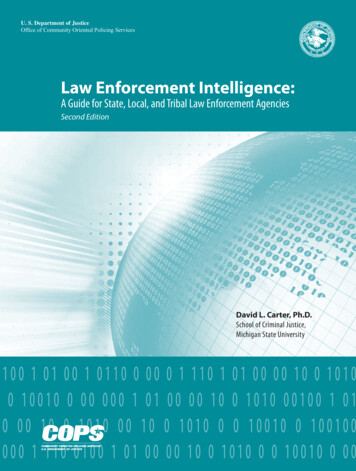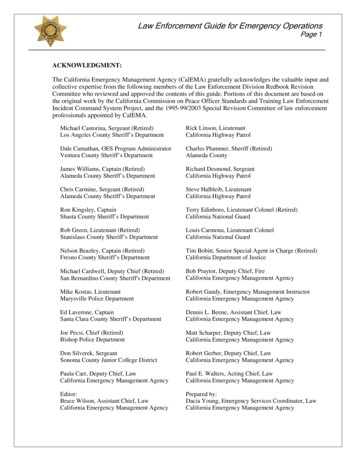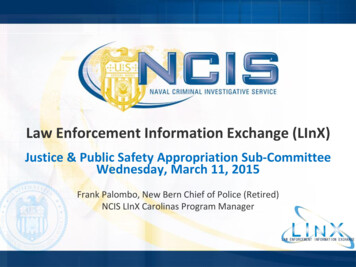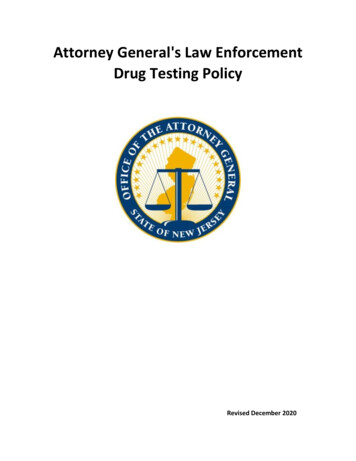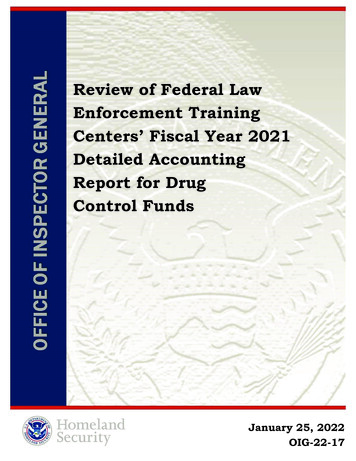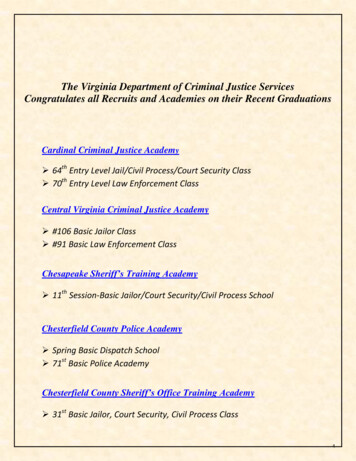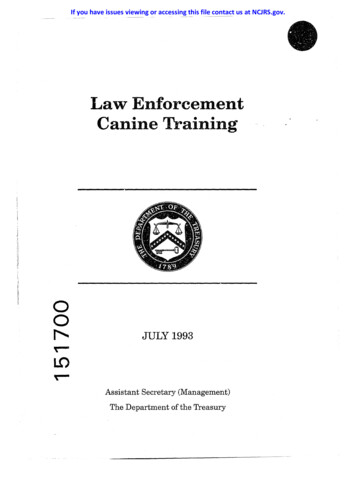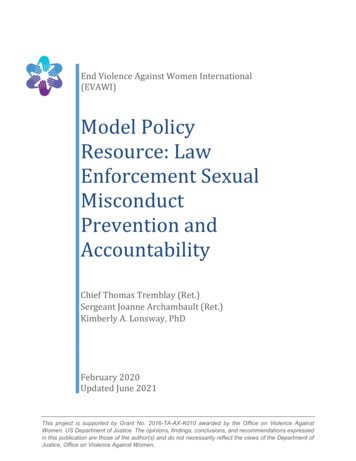
Transcription
End Violence Against Women International(EVAWI)Model PolicyResource: LawEnforcement SexualMisconductPrevention andAccountabilityChief Thomas Tremblay (Ret.)Sergeant Joanne Archambault (Ret.)Kimberly A. Lonsway, PhDFebruary 2020Updated June 2021.This project is supported by Grant No. 2016-TA-AX-K010 awarded by the Office on Violence AgainstWomen, US Department of Justice. The opinions, findings, conclusions, and recommendations expressedin this publication are those of the author(s) and do not necessarily reflect the views of the Department ofJustice, Office on Violence Against Women.
Model Policy Resource: Law Enforcement Sexual MisconductPrevention and AccountabilityTremblay, Archambault, LonswayJune2021Public Domain NoticeUnless something is excerpted directly from a copyrighted source, all the material in thisdocument is in the public domain and may be reproduced or copied without specificallyrequesting permission from End Violence Against Women International (EVAWI) or theauthors. Any direct quotes or excerpts should be properly cited, however. No one mayreproduce or distribute this material for a fee without the specific, written authorization ofEnd Violence Against Women International (EVAWI).Electronic AccessThis publication may be downloaded from End Violence Against Women International’sResource Library.Recommended CitationTremblay, T., Archambault, J., & Lonsway, K. (2021). Model Policy Resource: LawEnforcement Sexual Misconduct Prevention and Accountability. End Violence AgainstWomen International.Organizational FeaturesThroughout this document, the following icons are used to highlight promising practices,resources, and policy recommendations; material and language not generally used inagency policies and procedures.Innovative and promising practicesPolicy recommendationsResources and tools2End Violence Against Women Internationalwww.evawintl.org
Model Policy Resource: Law Enforcement Sexual MisconductPrevention and AccountabilityTremblay, Archambault, LonswayJune2021AuthorsChief Thomas Tremblay (Ret.) has a distinguished 30-year career inpolicing, serving as an officer, detective, supervisor, police chief, andstate public safety commissioner. Throughout his career, ChiefTremblay has been a passionate leader for the prevention of domesticand sexual violence. He is a retired Chief of Police from Burlington,Vermont, and the former Commissioner of the Vermont Department ofPublic Safety. He is now a highly regarded national and internationaladvisor and trainer for police, prosecutors, advocates, highereducation, the military, and the private sector.Chief Tremblay is a contracted subject matter expert on domestic violence and sexualassault for numerous organizations including the International Association of Chiefs ofPolice, National Center for Campus Public Safety, Police Executive Research Forum,Rape Abuse Incest National Network, RTI Sexual Assault Kit Initiative, Battered Women’sJustice Project, and the US Department of Justice, Civil Rights Division and Office onViolence Against Women. Chief Tremblay also assisted the US Department of Justice inpromoting gender bias prevention efforts for law enforcement response to domesticviolence and sexual assault, including prevention and accountability strategies to addresspolice perpetrated domestic violence and sexual misconduct.Sgt. Joanne Archambault (Retired, San Diego Police Department) isthe Chief Executive Officer for EVAWI. In 2003 prior to foundingEVAWI, Sgt. Archambault worked for the San Diego PoliceDepartment for almost 23 years, in a wide variety of assignments.During the last 10 years of her service, she supervised the Sex CrimesUnit, which had 13 detectives and was responsible for investigatingapproximately 1,000 felony sexual assaults each year. Sgt.Archambault has provided training for tens of thousands ofpractitioners, policymakers and others, and she has been instrumentalin creating system – level change through individual contacts, as well as policyinitiatives and recommendations for best practice.Dr. Kimberly A. Lonsway has served as the Director of Research forEVAWI since 2004. Her research focuses on sexual violence and thecriminal justice and community response system, and she has writtenover 60 published articles, reports, and documents. Over her career,she has trained thousands of professionals and volunteered for over15 years as a victim advocate. In 2012, she was awarded the first-everVolunteer of the Decade Award from the Sexual Assault Recovery andPrevention (SARP) Center in San Luis Obispo, California. She earnedher PhD in the Department of Psychology at the University of Illinois,Urbana-Champaign.3End Violence Against Women Internationalwww.evawintl.org
Model Policy Resource: Law Enforcement Sexual MisconductPrevention and AccountabilityTremblay, Archambault, LonswayJune2021AcknowledgementsWe are extremely grateful to the following individuals (listed in alphabetical order), fortheir valuable contributions to this Model Policy Resource: Law Enforcement SexualMisconduct Prevention and Accountability. Rachael Arietti, Senior Research Associate, Police Executive Research Forum,Washington, DC Ann Burdges, Board President, Cadre of Experts, EVAWI; Consultant / Trainer,Atlanta, GA Puneet Cheema, JD, Staff Attorney, Lambda Legal, Washington, DC Mike Davis, Cadre of Experts, EVAWI; Sergeant (Ret.), Vancouver WashingtonPolice Department, Vancouver, WA Maureen Evans, Cadre of Experts, EVAWI; Clery Compliance Coordinator, OldDominion University Police Department, Norfolk, VA Rachael Frost, Cadre of Experts, EVAWI; Master Investigator (Ret.), RiversideCounty Sheriff’s Office; Chief Executive Officer, ICED, Murrieta, CA Cathy Garcia, Cadre of Experts, EVAWI; Supervising Investigator (Ret.), DistrictAttorney’s Office, San Diego, CA Carlton Hershman, Cadre of Experts, EVAWI; Detective (Ret.), San Diego PoliceDepartment, San Diego, CA Catherine Johnson, Board Secretary, Cadre of Experts, EVAWI; Investigator,Beaufort, NC Richard Mankewich, Cadre of Experts, EVAWI; Sergeant, Orange County Sheriff’sOffice, Orlando, FL Michael Milnor, Chief (Ret.), Altavista VA Police Department; Consultant, Justice3D,Long Island, VA Sarah Mostyn, Research Associate, Police Executive Research Forum, Washington, DC Andrea Munford, Cadre of Experts, EVAWI; Lieutenant, Michigan State UniversityPolice Department; Advisor to the MSU Office of the President, East Lansing, MI4End Violence Against Women Internationalwww.evawintl.org
Model Policy Resource: Law Enforcement Sexual MisconductPrevention and AccountabilityTremblay, Archambault, LonswayJune2021 Bob Passonno, Coordinator, Criminal Justice Training Programs, New York StateOffice for the Prevention of Domestic Violence, Albany, NY Wendy Patrick, PhD, Cadre of Experts, EVAWI; Deputy District Attorney, San DiegoCounty District Attorney’s Office, San Diego, CA Andrea J. Ritchie, Researcher in Residence on Race, Gender, Sexuality andCriminalization, Barnard Center for Research on Women, New York, NY Michael Schentrup, Cadre of Experts, EVAWI; Patrol Support Commander,Gainesville Police Department, Gainesville, FL David R. Thomas, Program Manager II, International Association of Chiefs of Police,Alexandria, VA Judith Weber, Sergeant, (Ret.), San Diego Police Department, Frederick, MD5End Violence Against Women Internationalwww.evawintl.org
Model Policy Resource: Law Enforcement Sexual MisconductPrevention and AccountabilityTremblay, Archambault, LonswayJune2021IntroductionMost law enforcement officers serve their communities with honor and distinction,having taken an oath to protect all people, regardless of race, religion, gender, sexualorientation or social status. Any officer who misuses the power and authority of lawenforcement by engaging in sexual misconduct commits an extremely serious breach ofprofessional ethics, a violation of civil rights under the color of law, and traumaticvictimization of a colleague or member of the community whom law enforcement hassworn to protect. In more serious cases, they commit a violation of the criminal law theyare charged with enforcing. Public and private agencies have taken a variety of steps toprevent such misconduct and respond appropriately when it does happen.This document was created to help law enforcement agencies work collaboratively withagency personnel, community partners, and legal counsel to develop their own agencyspecific policy to address sexual misconduct committed by sworn and civilian personnel.It is provided in an accessible format that can be easily adapted by law enforcementagencies to create a new policy or build on an existing policy. 1BackgroundEfforts to address law enforcement sexual misconduct do not take place in a vacuum.Rather they reflect the growing national and international demand to improve responsesto all forms of sexual harassment and assault, including in criminal justice settings.In 2003, for example, the Prison Rape Elimination Act (PREA) was passed withunanimous, bipartisan support, with the goal of preventing rape and other forms ofsexual victimization against those in the custody and care of law enforcement. A corerequirement of PREA standards is that law enforcement agencies create a written policyaddressing “all forms of sexual abuse and sexual harassment and outlining theagency’s approach to preventing, detecting, and responding to such conduct.” PREA’srequirements for sexual abuse prevention, detection, and response are applicable tolaw enforcement agencies’ facilities such as holding cells, where civilians are detainedin facilities within a law enforcement agency’s jurisdiction and control.This model policy resource is provided in Word, so agencies can easily revise the document to reflecttheir own policies, procedures, and formatting. This will often require tailoring the specific language usedfor agency units and personnel. For example, we use the term “officer” throughout this model policyresource, but we recognize that agencies use different titles for sworn personnel (e.g., agent, trooper,deputy). Many agencies also have specific Units they will want to refer to in this policy, such as InternalAffairs (IA), Professional Standards Unit (PSU) and the Office of Professional Responsibility (OPR) orStandards (OPS). No authorization or attribution is required to adapt this material to an agency’s policiesand procedures. On the contrary, our hope is that we have made it as easy as possible to implement therecommendations identified in this policy.16End Violence Against Women Internationalwww.evawintl.org
Model Policy Resource: Law Enforcement Sexual MisconductPrevention and AccountabilityTremblay, Archambault, LonswayJune2021In 2011, the International Association of Chiefs of Police (IACP) worked with lawenforcement leaders from across the country to develop an Executive Guide for AddressingSexual Offenses and Misconduct by Law Enforcement. This Guide advises lawenforcement agencies to adopt policies specifically addressing sexual misconductcommitted against members of the public by law enforcement. The Guide also encouragesagencies to apply the same principles to all employees, civilian and sworn, as appropriate.In 2015, the United States Department of Justice (DOJ) similarly published guidance onIdentifying and Preventing Gender Bias in Law Enforcement Response to Sexual Assaultand Domestic Violence. This document outlines eight core principles for law enforcementagencies to follow in pursuit of this objective, including the recommendation that lawenforcement agencies develop policies and practices aimed at holding officers who commitdomestic violence and sexual assault, including sexual assault committed while actingunder the color of law, accountable.In 2017, the US Department of Justice, Office of Community Oriented Policing Services(COPS Office) published Gender, Sexuality, and 21st Century Policing: Protecting theRights of the LGBTQ Community. Appendix B of this report includes a 9-page samplepolicy 2 that addresses PREA standards as well as sexual harassment and misconductperpetrated by law enforcement against members of the public.In 2021, the San Diego Police Department (SDPD) implemented a new policyguiding officer interactions with transgender and gender-nonbinary people. Thispolicy was created in partnership with the local LGBTQ community and is designedto create a mutual understanding among community members and the policedepartment to prevent conflict and ensure appropriate interactions. A few of the keycomponents include the following: A search or pat down shall not be performed for the sole purpose ofdetermining an individual's anatomical gender. Transgender and gender non-binary individuals shall not be subject to moreinvasive search or frisk procedures than non-transgender or cisgenderindividuals based solely on transgender or gender non-binary status. When an arresting officer has reason to believe the arrestee is a transgenderperson or gender non-binary person, the officer shall specifically inform thearrestee that, as with any other arrestee, he/she/they must be searched. Theofficer shall ask the arrestee if there is a preference to be searched by a maleor female officer. If the arrestee's gender request can be reasonably and2Thissample policy was developed by Andrea J. Ritchie, and the Policing Subgroup of the LGBT/HIVFederal Criminal Justice Policy Working Group. Ms. Ritchie is a police misconduct attorney, and a 2014Senior Soros Justice Fellow, with more than two decades of experience advocating against policeviolence and the criminalization of women and LGBT people of color.7End Violence Against Women Internationalwww.evawintl.org
Model Policy Resource: Law Enforcement Sexual MisconductPrevention and AccountabilityTremblay, Archambault, LonswayJune2021expeditiously accommodated without risk to officer safety, the request shouldbe granted. Officers transporting transgender or gender non-binary individuals aspassengers or prisoners shall notify the radio dispatcher of their beginningmileage and ending mileage. Booking transgender and nonbinary people into a jail facility that aligns withtheir preferred identity.Importance of LeadershipStrong leadership on any important issue must begin at the top. And the more sensitiveand controversial an issue is, the stronger the leadership must be to convey and modelthe appropriate message and guide corrective actions. Command staff must thereforeact as role models and communicate in no uncertain terms that sexual misconduct ofany kind will not be tolerated, and that the agency will make every effort to prevent,accurately document, appropriately investigate, fairly adjudicate, and sufficientlydiscipline offenders for any such reports that are sustained and/or prosecuted. Thismessage can be communicated both verbally and through the personal behaviors ofthose in top command at every available opportunity. Yet this must be supplementedwith executive leadership that underscores the message, by ensuring that supervisorsand command staff have the authority and resources to comply with this policy.For more information on law enforcement sexual misconduct, see EVAWI’sarchived webinar, Public Trust: Confronting Law Enforcement Misconduct in the#MeToo Era. This 90-minute presentation was given by Chief Tom Tremblay,and it was designed to encourage courageous conversations and inspireproactive leadership to prevent and address law enforcement sexual misconduct.Model Policy LanguagePurposeThis agency acknowledges the responsibility of law enforcement to proactively developpolicies, procedures, training, and supervision to prevent and effectively address anysexual misconduct committed by agency personnel, whether sworn or civilian. Bydeveloping and implementing this policy, our agency is taking a leadership position toaddress the serious problem of law enforcement sexual misconduct, and to model bestpractices and accountability for the law enforcement profession.8End Violence Against Women Internationalwww.evawintl.org
Model Policy Resource: Law Enforcement Sexual MisconductPrevention and AccountabilityTremblay, Archambault, LonswayJune2021PolicyIt is the policy of this agency to proactively address and prevent law enforcement sexualmisconduct and to hold agency personnel responsible for any violations. This agencystrictly prohibits sexual harassment, sexual assault, or sexual abuse of any member ofthe community or fellow employee by any member of the agency. All agency personnelare required to report suspected violations of this policy, and reports will be thoroughlyand fairly investigated in accordance with all relevant laws (federal, state, and tribal),agency policies, human resource guidelines, and collective bargaining agreements. Ifany report includes behavior that could potentially meet the legal elements for a criminaloffense, separate but concurrent administrative and criminal investigations shall beconducted.Agency personnel found responsible for violating this policy will be subject to disciplineup to and including suspension, termination, and/or decertification. Reports involvingcriminal behavior will be referred to the prosecutor’s office to evaluate possible charges.Any required documentation for decertification procedures will be forwarded to thecertifying agency, in accordance with state law, agency policy, and relevant regulations.Defining Law Enforcement Sexual MisconductLaw enforcement sexual misconduct is generally defined as including sexualharassment, sexual assault, sexual battery, and any inappropriate or unwanted sexualbehavior 3 committed against a member of the community or fellow employee by agencypersonnel. It also includes any sexual act committed by agency personnel while onduty, or while acting under the color of law, or any sexual act committed while off-dutybut involving agency or government equipment, or within agency/government propertyor vehicles, involving the use of a service weapon, or information obtained through lawenforcement activity or databases, or secured through threat of taking or denying officialaction. Consent is not an affirmative defense when engaging in sexual misconduct. Theterm “agency personnel” is an inclusive term including all law enforcement agencyemployees, sworn and non-sworn.Sexual misconduct also includes behavior that takes advantage of a law enforcementposition to misuse authority and power (including force, or threats of force, arrest,charging, ticketing, reporting to immigration or child welfare authorities, refusal toinvestigate a crime, etc.)) to commit a sexual act, initiate sexual contact with anotherperson, or respond to a perceived sexually motivated cue (from a subtle suggestion toan overt action) by another person. It also includes any communication or behavior byFor more information about the overlap (and non-overlap) of the definitions for sexual harassment andsexual assault, please see EVAWI’s (2018) training bulletin entitled, Sexual Harassment and SexualAssault: Understanding the Distinctions and Intersections.39End Violence Against Women Internationalwww.evawintl.org
Model Policy Resource: Law Enforcement Sexual MisconductPrevention and AccountabilityTremblay, Archambault, LonswayJune2021agency personnel that would likely be construed by a reasonable person as lewd orlascivious, or that is sexually inappropriate, nonprofessional, or violates generalprinciples of acceptable conduct common to law enforcement agencies for maintainingthe public’s trust. 4Acting Under the Color of LawTitle 18 USC. Section 242 makes it a crime for a person acting under color of any law towillfully deprive a person of a right or privilege protected by the Constitution or laws ofthe United States. This applies to all agency personnel, sworn and non-sworn, includingpolice officers, prison guards and other law enforcement officials, as well as judges,care providers in public health facilities, and others who are acting as public officials. Itincludes all acts while on-duty, and can include off-duty conduct when agencypersonnel are purporting to, or pretending to, act in the performance of their officialduties (e.g., off-duty contacts or visits to crime victims, witnesses, or suspects, use ofgovernment vehicle or service weapon, threats of criminal prosecution or refusal toinvestigate).Consent is not an affirmative defense when engaging in sexual misconduct while actingunder the color of law.Prohibited ConductProhibited behaviors may include, but are not limited to, the following: Any criminal conduct of a sexual nature as defined by state, federal, or tribal laws(e.g., sexual assault, sexual battery, rape). Exposing any uncovered genitalia, buttocks, or breasts to a member of thecommunity or co-worker. Engaging in sexual acts or behavior while on-duty, when in uniform, or using agencyor government equipment such as laptops and cellular phones (e.g., sexting, takingunnecessary or inappropriate photos/videos of community members, detainees, orco-workers). Possessing or sending sexually inappropriate material while on-duty, unless theemployee can demonstrate a legitimate agency interest in the activity, for exampleas part of an investigation into criminal activity or employee misconduct. Using a law enforcement position, badge, or identification card to solicit, initiate, orThis definition and the examples of prohibited behavior are adapted from the IACP’s (2011) ExecutiveGuide: Addressing Sexual Offenses and Misconduct by Law Enforcement.410End Violence Against Women Internationalwww.evawintl.org
Model Policy Resource: Law Enforcement Sexual MisconductPrevention and AccountabilityTremblay, Archambault, LonswayJune2021coerce sexual contact with anyone. This includes sexual “shakedowns” (e.g.,extorting sexual favors in exchange for not ticketing or arresting a member of thecommunity). Unnecessary contacts that are nonprofessional and sexually motivated (e.g.,unwarranted call backs or visits to crime victims, witnesses, or suspects, making atraffic stop to get a closer look at the driver for nonprofessional reasons). Inappropriate and unauthorized use of agency resources or information systems(e.g., obtaining telephone numbers or addresses of community members), forpurposes that are nonprofessional, sexually motivated, or as part of a pattern ofdomestic violence and/or stalking behaviors. Attempting to initiate sexual contact or engaging in a sexual act with anyonecontacted within the context of law enforcement duties and activities, even if off-duty. Attempting to initiate sexual contact or engaging in a sexual act with any juvenile,including participants in a Police Explorer program or other youth program (such asDrug Abuse Resistance Education (DARE) or Gang Resistance Education andTraining (GREAT), or between School Resource Officers and students. Voyeuristic acts committed against community members (e.g., looking in residencesor vehicles for sexually motivated purposes, or as part of a pattern of stalkingbehaviors). Voyeuristic acts committed against detainees, including invasions of privacy that areunrelated to official duties (e.g., peering at an arrestee using a toilet; requiring anarrestee to expose his/her buttocks, genitals, or breasts; or taking images of all orpart of an arrestee's naked body or of an arrestee performing bodily functions). Gratuitous physical contact with suspects or detainees (e.g., inappropriate orunnecessary searches, frisks, or pat downs).Mandatory Reporting of Suspected ViolationsAgency personnel are required to immediately report any knowledge, suspicion, orinformation regarding possible violations of this policy to their direct supervisor. If thesuspected policy violation involves the direct supervisor, the incident/information shallbe reported to the next person in the chain of command as soon as possible. If thereported incident involves the chief executive of a law enforcement agency, thesupervisor shall immediately notify the appropriate prosecutors for the jurisdiction andthe individual in government who has direct oversight of the individual.11End Violence Against Women Internationalwww.evawintl.org
Model Policy Resource: Law Enforcement Sexual MisconductPrevention and AccountabilityTremblay, Archambault, LonswayJune2021Because of the sensitive nature of any complaints involving an individual in the chain ofcommand, reports can also be made directly to the Unit responsible for conductingadministrative investigations of officer misconduct, and can be made to the HumanResources/Equal Employment Opportunity Office, as applicable and appropriate. Anypersonnel who experience sexual misconduct also have a legal right to file a complaintwith the US Federal Equal Opportunity Commission (EEOC) and/or a state EEOC agency.If agency personnel have knowledge or suspicion that officers or employees who workat another law enforcement agency have committed behaviors that would constitute aviolation of this policy, they shall immediately provide this information to their directsupervisor. The supervisor will coordinate with the chain of command to determine if theinformation requires a criminal investigation, and if so, determine what agency hasjurisdiction over that investigation. The supervisor will also ensure that information abouta suspected code of conduct violation is reported to the agency of the suspectedofficer/employee as soon as practically possible.Personnel who learn or suspect that they are being investigated by another lawenforcement agency for behavior that could potentially constitute a violation of thispolicy (whether a criminal investigation or an administrative investigation for off-dutyconduct), must immediately report this fact to their direct supervisor. The supervisor willnotify the chain of command to ensure adherence to this policy.Immediate action will be taken to maintain the complainant’s privacy and protect thecomplainant from retaliation or other adverse consequences of reporting. Additionally,the complainant will immediately be referred to a local sexual assault advocacyorganization and to the civilian oversight agency, where available.Personnel who fail to comply with the mandatory reporting requirements described inthis policy will be subject to discipline up to and including, suspension, termination,and/or decertification.Confidentiality ProtectedAny personnel receiving a report of possible policy violations shall not reveal informationabout the report, beyond what is required to fulfill mandatory reporting requirements.Retaliation ProhibitedAny members of the community or agency personnel reporting possible violations of thispolicy shall be protected from retaliation. No agency personnel will harass or retaliateagainst any reporting person or potential witness. Agency personnel found to beresponsible for harassment or retaliation of a reporting person or potential witness will besubject to discipline up to and including suspension, termination, and/or decertification.12End Violence Against Women Internationalwww.evawintl.org
Model Policy Resource: Law Enforcement Sexual MisconductPrevention and AccountabilityTremblay, Archambault, LonswayJune2021Training and PreventionThis agency recognizes the value of training for prevention and appropriate response tosexual misconduct. A variety of strategies will be used for training personnel, includingthe basic academy, in-service, roll call, and Field Training Officer (FTO) programs, aswell as training bulletins and other national resources, to regularly reinforce this policyand provide mandatory comprehensive training. Required topics will include: Law enforcement authority, oath, ethics, and civil rights. Defining law enforcement sexual misconduct and color of law, including caseexamples for on-duty and off-duty violations. Predatory behavior and common conduct of sexual offenders such as targeting,testing, grooming, isolation, and other “power and control” behaviors. Early warning signs and bystander intervention strategies for sexual misconduct. Mandatory reporting responsibilities and reporting mechanisms. Responsibilities of supervisors. Confidentiality protections for reporting parties and witnesses. Prohibited retaliation against reporting parties and witnesses. Potential disciplinary outcomes and criminal prosecution. Special considerations regarding frisks and searches of persons.Training will also cover agreements with advocacy organizations or other agenciesregarding reporting protocols (e.g., Memoranda of Understanding). For example,community members might be provided information that they can report sexualmisconduct to an entity other than the law enforcement agency involved in thecomplaint – either the advocacy organization, prosecutor’s office, or another lawenforcement agency.Finally, training will address the special considerations pertaining to vulnerablepopulations (including children, teens, runaways, homeless individuals, victims ofhuman trafficking, people who are prostituted, and individuals with addictions, mentalillness, and physical/cognitive disabilities), as well as LGBTQ community members.13End Violence Against Women Internationalwww.evawintl.org
Model Policy Resource: Law Enforcement Sexual MisconductPrevention and AccountabilityTremblay, Archambault, LonswayJune2021Pre-Hiring and ScreeningOne of the best prevention efforts is to ensure that recruits are screened carefully forabusive behaviors that might escalate to sexual misconduct. Candidates will thereforebe asked if they have engaged in, or ever been investigated for, sexual harassment,sexual assault, domestic violence, elder abuse, or child molestation. This includes anypast discipline within their employment history, as well as their educational or militaryexperience. Background investigations must also determine whether the candidate hasany past arrests, convictions, suspended or de
criminal justice and community response system, and she has written over 60 published articles, reports, and documents. Over her career, . Old Dominion University Police Department, Norfolk, VA Rachael Frost, Cadre of Experts, EVAWI; Master Investigator (Ret.), Riverside County Sheriff's Office; Chief Executive Officer, ICED, Murrieta, CA
